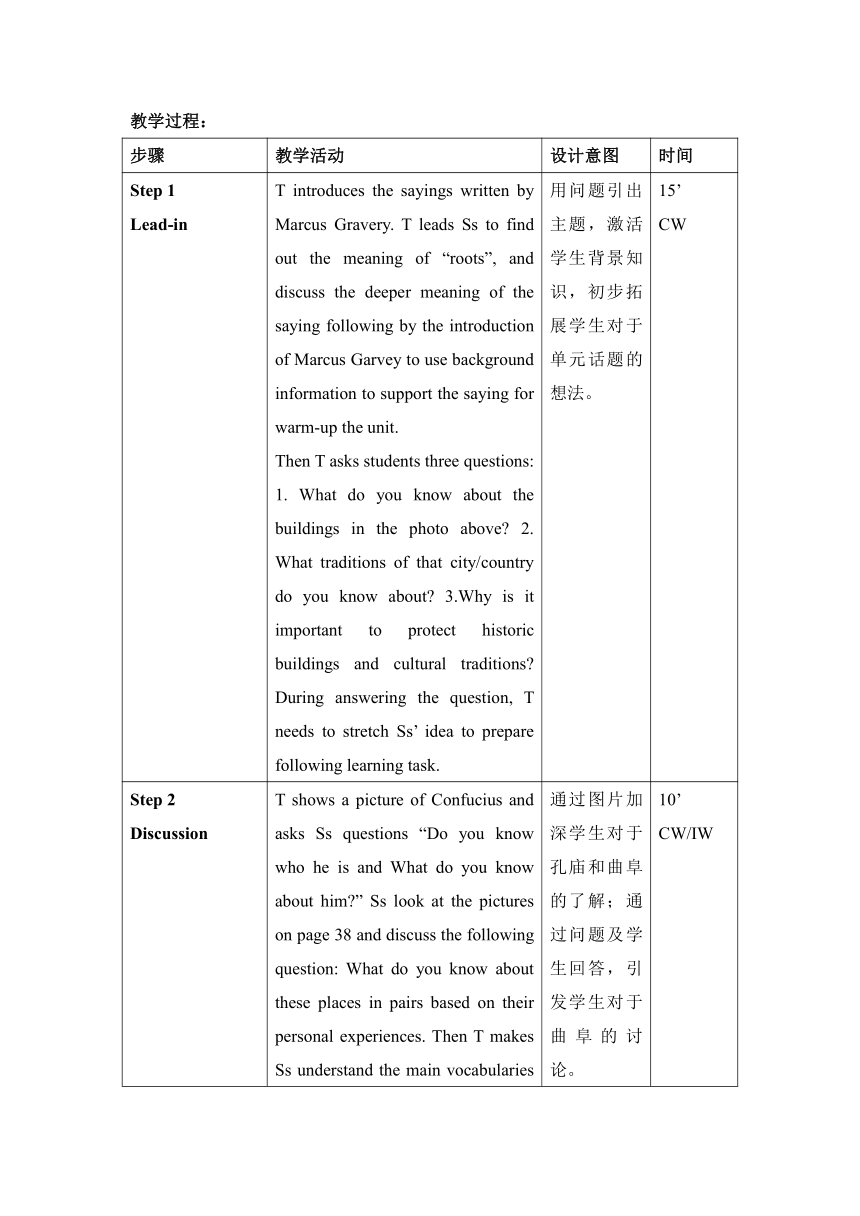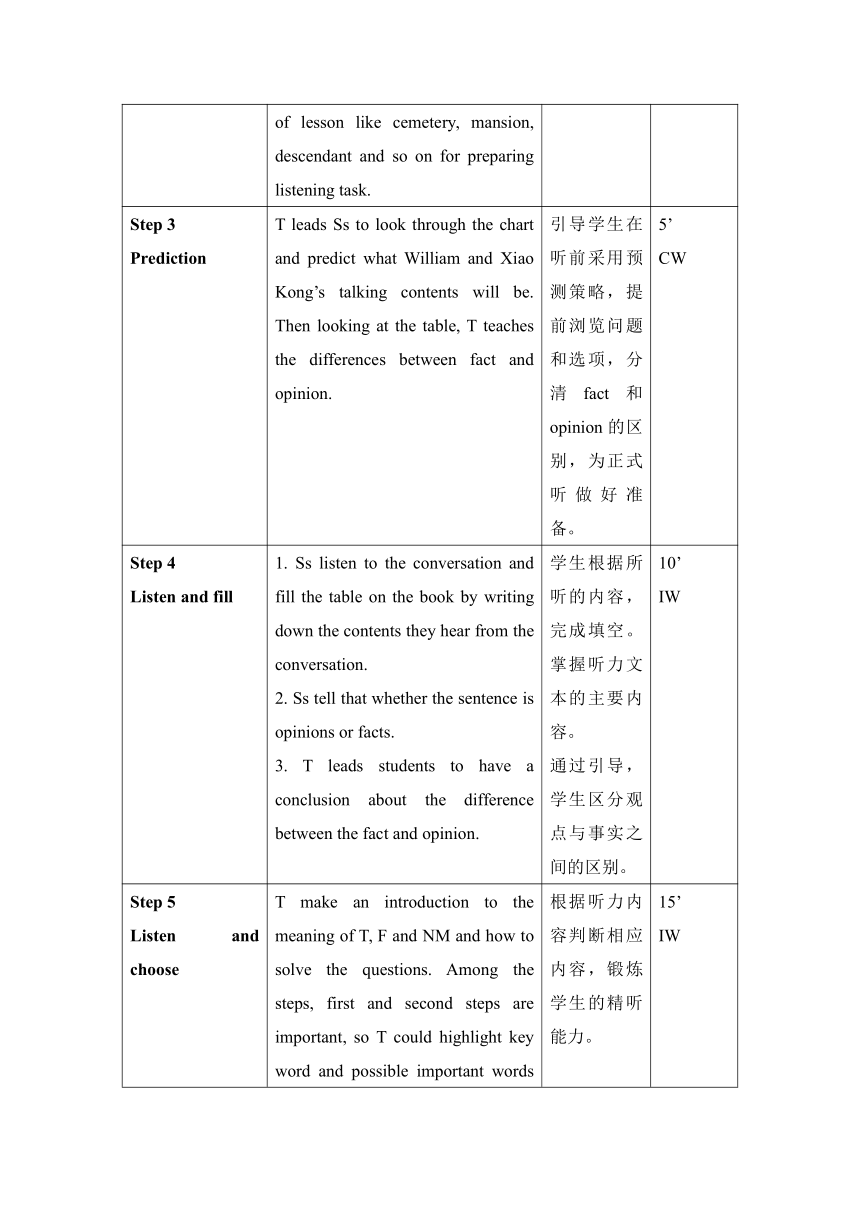人教版(2019)必修第二册Unit 4 History and Tradition Listening and Speaking教案(表格式)
文档属性
| 名称 | 人教版(2019)必修第二册Unit 4 History and Tradition Listening and Speaking教案(表格式) |  | |
| 格式 | docx | ||
| 文件大小 | 19.4KB | ||
| 资源类型 | 教案 | ||
| 版本资源 | 人教版(2019) | ||
| 科目 | 英语 | ||
| 更新时间 | 2024-04-02 09:52:20 | ||
图片预览



文档简介
Unit 4 History and Tradition
Listening and Speaking教案
教材分析:
本课时主要包含一段对话型的听力材料,听力文本中主要涉及孔子及其教育理念、中英习语及其解释,学生需要学会提取关键信息,并在语境当中猜测词义,课前活动采用图片导入和讨论,使学生熟悉相关话题,可对文本进行预测。文本中的难点词汇如:mansion、cemetery、philosophy等需进一步讲解。
教学策略与设计说明:
采用任务型教学法(Task-based language teaching),布置活动任务,设置活动目的,引导学生完成相关任务,达成各个教学步骤的设计目的。
教学目标:
在本课学习结束时,学生能够:
语言能力上,了解Achilles’ heel、 pull one’s leg等习语的释义及用法。能够获取听力材料信息并进行判断。练习连读发音规则。
思维品质上,辩证思考孔子教育理论,梳理了解对话中孔子的相关事实性信息并进行概括整合对听力内容进行预测和推理。
文化品格上,学会学习接纳不同文化,在了解中国古代哲学的过程中形成更高的文化的认同感。
学习能力上,习得如何根据发音规则,练习连读发音,并能自主练习的学习能力。
教学重点:
学生能够掌握听前预测的技能,并能对听力内容进行梳理整合。
完整地表达自身对于孔子教育观念的看法。
教学难点:
学生能够对听力内容进行预测和推理。
熟练掌握文本中英语习语。
准确地用英语表达自身的观点。
教学资源:黑板、粉笔、多媒体
教学过程:
步骤 教学活动 设计意图 时间
Step 1 Lead-in T introduces the sayings written by Marcus Gravery. T leads Ss to find out the meaning of “roots”, and discuss the deeper meaning of the saying following by the introduction of Marcus Garvey to use background information to support the saying for warm-up the unit. Then T asks students three questions: 1. What do you know about the buildings in the photo above 2. What traditions of that city/country do you know about 3.Why is it important to protect historic buildings and cultural traditions During answering the question, T needs to stretch Ss’ idea to prepare following learning task. 用问题引出主题,激活学生背景知识,初步拓展学生对于单元话题的想法。 15’ CW
Step 2 Discussion T shows a picture of Confucius and asks Ss questions “Do you know who he is and What do you know about him ” Ss look at the pictures on page 38 and discuss the following question: What do you know about these places in pairs based on their personal experiences. Then T makes Ss understand the main vocabularies of lesson like cemetery, mansion, descendant and so on for preparing listening task. 通过图片加深学生对于孔庙和曲阜的了解;通过问题及学生回答,引发学生对于曲阜的讨论。 10’ CW/IW
Step 3 Prediction T leads Ss to look through the chart and predict what William and Xiao Kong’s talking contents will be. Then looking at the table, T teaches the differences between fact and opinion. 引导学生在听前采用预测策略,提前浏览问题和选项,分清fact和opinion的区别,为正式听做好准备。 5’ CW
Step 4 Listen and fill 1. Ss listen to the conversation and fill the table on the book by writing down the contents they hear from the conversation. 2. Ss tell that whether the sentence is opinions or facts. 3. T leads students to have a conclusion about the difference between the fact and opinion. 学生根据所听的内容,完成填空。掌握听力文本的主要内容。 通过引导,学生区分观点与事实之间的区别。 10’ IW
Step 5 Listen and choose T make an introduction to the meaning of T, F and NM and how to solve the questions. Among the steps, first and second steps are important, so T could highlight key word and possible important words with Ss. Ss listen again and choose the right answer for the statements. And T analyses script sentence by sentence. 根据听力内容判断相应内容,锻炼学生的精听能力。 15’ IW
Step 6 Discussion T tells Ss who Shakespeare was and lists some works. Then, T asks Ss to discuss Why Xiao Kong says Confucius and Shakespeare are two of the greatest minds in history. T shows some aspects to make Ss to think deeply. 拓展知识面,深度了解语篇内容,辩证思考莎士比亚和孔子的共同点和不同点。 8’ GW/CW
Step 7 Key words T leads Ss to learn the new words such as by presenting the pictures, collocations and example sentences. Ss understand the words in the sentence and take notes. 利用图片,激发学生学习的兴趣,提供语境巩固词汇。 6’ CW
Step 8 Write and Explain T teaches students the definitions for idioms and have an example for students to help them understand it better. T asks Ss to recall the meaning of some phrases to fill the chart on the book and explain the definition and functions of idioms. T uses pictures to lead Ss to understand these idioms more easily. Then T divides them into three kinds of idioms. Ss create dialogues with the idioms that they have learnt in the class for practicing the idioms. 引导学生回顾对话,写出书中习语的含义,引导学生理解习语在英语中的意义和作用,使用所学习语创造对话,将知识转化为能力。 15’ CW/IW
Step 9 Watch a video T plays an interactive video for reviewing different kinds of idioms and strengthening Ss’ understanding. Also, T can divide Ss into 2 groups and ask them to answer questions appearing on screen ASAP. 利用视频和学生互动,趣味加强对于习语的理解,调动学生新知。 3’ CW/GW
Step 10 Discuss T invites students to have a discussion in group about the three questions on the book to have a better understanding of Confucius and let the students express their own idea towards his education ideas. 引导学生讨论孔子的教育理念及学生对于其教育理念的看法,有助于巩固对于孔子 的事实性认知,有助于培养学生的批判性思维。 10’ GW
Step 11 Pronunciation T leads Ss to have a basic understanding of the poet and know the basic rules of sound-linking. T asks Ss to read the poems to the class and then makes students notice some pronunciation key points. Ss listen to the records carefully and repeat the reading themselves to practice. Ss read the poems together to feel the beauty of the poem. 介绍诗人及连读规则,通过学生自己朗读找到发音的不规范之处,结合书本提示及录音,老师引导学生进行正确发音,最后通过班级共同朗读体会英文诗歌的魅力。 15’ CW/IW
Step 10 Summary & Homework T invites the class to summarize what they have learned. Homework: There comes an exchange student who wants to know some historical sites in China. Please choose a site that you know most to introduce. 巩固所学知识; 通过情景,学生谈论一个新的地点,回顾谈论和分享观点的语句。 3’ IW
备注:T: Teacher Ss: Students
IW: Individual work GW: Group work CW: Class work
教学反思:
学生通过本课时学习,能否熟练掌握有关孔子及其相关的重点单词词组及句型,并在正确场合进行表达。
学生通过本课时学习,能否辩证思考孔子教育理论,体会中西文化中习语存在的异同。
学生通过本课时学习,能否运用所学的词汇、短语和句型,独立自主地表达自己对于某一历史景点的看法。
Listening and Speaking教案
教材分析:
本课时主要包含一段对话型的听力材料,听力文本中主要涉及孔子及其教育理念、中英习语及其解释,学生需要学会提取关键信息,并在语境当中猜测词义,课前活动采用图片导入和讨论,使学生熟悉相关话题,可对文本进行预测。文本中的难点词汇如:mansion、cemetery、philosophy等需进一步讲解。
教学策略与设计说明:
采用任务型教学法(Task-based language teaching),布置活动任务,设置活动目的,引导学生完成相关任务,达成各个教学步骤的设计目的。
教学目标:
在本课学习结束时,学生能够:
语言能力上,了解Achilles’ heel、 pull one’s leg等习语的释义及用法。能够获取听力材料信息并进行判断。练习连读发音规则。
思维品质上,辩证思考孔子教育理论,梳理了解对话中孔子的相关事实性信息并进行概括整合对听力内容进行预测和推理。
文化品格上,学会学习接纳不同文化,在了解中国古代哲学的过程中形成更高的文化的认同感。
学习能力上,习得如何根据发音规则,练习连读发音,并能自主练习的学习能力。
教学重点:
学生能够掌握听前预测的技能,并能对听力内容进行梳理整合。
完整地表达自身对于孔子教育观念的看法。
教学难点:
学生能够对听力内容进行预测和推理。
熟练掌握文本中英语习语。
准确地用英语表达自身的观点。
教学资源:黑板、粉笔、多媒体
教学过程:
步骤 教学活动 设计意图 时间
Step 1 Lead-in T introduces the sayings written by Marcus Gravery. T leads Ss to find out the meaning of “roots”, and discuss the deeper meaning of the saying following by the introduction of Marcus Garvey to use background information to support the saying for warm-up the unit. Then T asks students three questions: 1. What do you know about the buildings in the photo above 2. What traditions of that city/country do you know about 3.Why is it important to protect historic buildings and cultural traditions During answering the question, T needs to stretch Ss’ idea to prepare following learning task. 用问题引出主题,激活学生背景知识,初步拓展学生对于单元话题的想法。 15’ CW
Step 2 Discussion T shows a picture of Confucius and asks Ss questions “Do you know who he is and What do you know about him ” Ss look at the pictures on page 38 and discuss the following question: What do you know about these places in pairs based on their personal experiences. Then T makes Ss understand the main vocabularies of lesson like cemetery, mansion, descendant and so on for preparing listening task. 通过图片加深学生对于孔庙和曲阜的了解;通过问题及学生回答,引发学生对于曲阜的讨论。 10’ CW/IW
Step 3 Prediction T leads Ss to look through the chart and predict what William and Xiao Kong’s talking contents will be. Then looking at the table, T teaches the differences between fact and opinion. 引导学生在听前采用预测策略,提前浏览问题和选项,分清fact和opinion的区别,为正式听做好准备。 5’ CW
Step 4 Listen and fill 1. Ss listen to the conversation and fill the table on the book by writing down the contents they hear from the conversation. 2. Ss tell that whether the sentence is opinions or facts. 3. T leads students to have a conclusion about the difference between the fact and opinion. 学生根据所听的内容,完成填空。掌握听力文本的主要内容。 通过引导,学生区分观点与事实之间的区别。 10’ IW
Step 5 Listen and choose T make an introduction to the meaning of T, F and NM and how to solve the questions. Among the steps, first and second steps are important, so T could highlight key word and possible important words with Ss. Ss listen again and choose the right answer for the statements. And T analyses script sentence by sentence. 根据听力内容判断相应内容,锻炼学生的精听能力。 15’ IW
Step 6 Discussion T tells Ss who Shakespeare was and lists some works. Then, T asks Ss to discuss Why Xiao Kong says Confucius and Shakespeare are two of the greatest minds in history. T shows some aspects to make Ss to think deeply. 拓展知识面,深度了解语篇内容,辩证思考莎士比亚和孔子的共同点和不同点。 8’ GW/CW
Step 7 Key words T leads Ss to learn the new words such as by presenting the pictures, collocations and example sentences. Ss understand the words in the sentence and take notes. 利用图片,激发学生学习的兴趣,提供语境巩固词汇。 6’ CW
Step 8 Write and Explain T teaches students the definitions for idioms and have an example for students to help them understand it better. T asks Ss to recall the meaning of some phrases to fill the chart on the book and explain the definition and functions of idioms. T uses pictures to lead Ss to understand these idioms more easily. Then T divides them into three kinds of idioms. Ss create dialogues with the idioms that they have learnt in the class for practicing the idioms. 引导学生回顾对话,写出书中习语的含义,引导学生理解习语在英语中的意义和作用,使用所学习语创造对话,将知识转化为能力。 15’ CW/IW
Step 9 Watch a video T plays an interactive video for reviewing different kinds of idioms and strengthening Ss’ understanding. Also, T can divide Ss into 2 groups and ask them to answer questions appearing on screen ASAP. 利用视频和学生互动,趣味加强对于习语的理解,调动学生新知。 3’ CW/GW
Step 10 Discuss T invites students to have a discussion in group about the three questions on the book to have a better understanding of Confucius and let the students express their own idea towards his education ideas. 引导学生讨论孔子的教育理念及学生对于其教育理念的看法,有助于巩固对于孔子 的事实性认知,有助于培养学生的批判性思维。 10’ GW
Step 11 Pronunciation T leads Ss to have a basic understanding of the poet and know the basic rules of sound-linking. T asks Ss to read the poems to the class and then makes students notice some pronunciation key points. Ss listen to the records carefully and repeat the reading themselves to practice. Ss read the poems together to feel the beauty of the poem. 介绍诗人及连读规则,通过学生自己朗读找到发音的不规范之处,结合书本提示及录音,老师引导学生进行正确发音,最后通过班级共同朗读体会英文诗歌的魅力。 15’ CW/IW
Step 10 Summary & Homework T invites the class to summarize what they have learned. Homework: There comes an exchange student who wants to know some historical sites in China. Please choose a site that you know most to introduce. 巩固所学知识; 通过情景,学生谈论一个新的地点,回顾谈论和分享观点的语句。 3’ IW
备注:T: Teacher Ss: Students
IW: Individual work GW: Group work CW: Class work
教学反思:
学生通过本课时学习,能否熟练掌握有关孔子及其相关的重点单词词组及句型,并在正确场合进行表达。
学生通过本课时学习,能否辩证思考孔子教育理论,体会中西文化中习语存在的异同。
学生通过本课时学习,能否运用所学的词汇、短语和句型,独立自主地表达自己对于某一历史景点的看法。
